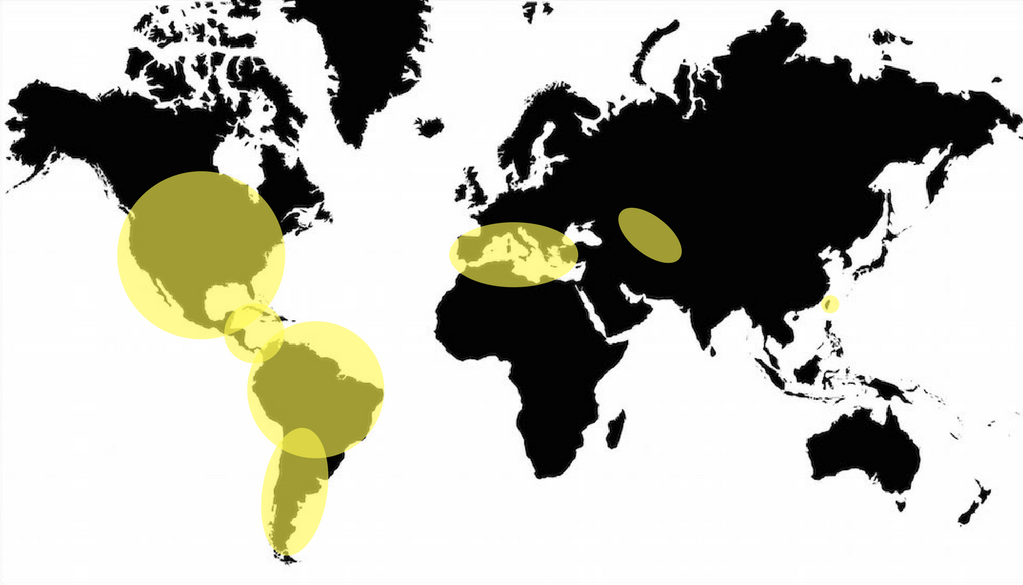| Line 1: | Line 1: | ||
{{Aix-Marseille}} | {{Aix-Marseille}} | ||
<h1>Description</h1> | <h1>Description</h1> | ||
| + | |||
| + | [[File:T--Aix-Marseille--Xylellaworld.png]] | ||
==Insight into one of the most virulent plant pathogens== | ==Insight into one of the most virulent plant pathogens== | ||
Revision as of 12:44, 16 August 2017
{{{title}}}
Contents
Description
Insight into one of the most virulent plant pathogens
Nerium oleander infected with deadly strain of bacterium Xylella fastidiosa, from Pompilid. ELLIOT W. KITAJIMA, UNIV. SAO PAULO. Bevan, M. Plant pathology: The bugs from Brazil. Nature 406, 140–141 (2000) James Lindsey at Ecology of Commanster
Xylella fastidiosa is a bacterium that infects plants, causing a variety of diseases in over 150 plant species, including olive trees, grapevines, citrus, almond trees, coffee plant, and many other economically important species. The diseases have many names: Pierce’s Disease of grape, citrus variegated chlorosis, phony peach disease, periwinkle wilt, almond leaf scorch, oleander leaf scorch and coffee leaf scorch, but are all caused by the same bacteria. X. fastidiosa is transmitted from plant to plant by Xylem-feeding insects.
Although X. fastidiosa has been recognized as a serious pathogen, there is no effective management strategy, due in part to a limited understanding of X. fastidiosa host-plant interactions affecting virulence and pathogenesis. There are no methods proven to cure trees from X. fastidiosa infection. The removal of infected trees is generally ineffective in reducing the spread of disease within a plot because X. fastidiosa is primarily spread by insects.
Given the current risk of X. fastidiosa spreading, our project is to develop an effective and environmentally friendly cure for the disease.
Using phages against Xylella fastidiosa
An electron micrograph of bacteriophages attached to a bacterium, from Graham Beards
Xylella fastidiosa is currently causing an epidemic that lacks any effective management strategy. One solution consistent with the objective of iGEM is to engineer a phage both specific and lethal to the bacterium, but without posing any harmful effects to associated beneficial microflora.
Bacteriophages are a class of extremely specific viruses that infect bacteria and lack the ability to infect more complex organisms such as mammals. This approach to the problem seems very promising.
So what is the purpose of our group ? We aim is to create phage-like particles that will be efficient and non-replicative but kill X. fastidiosa. This will give us a safe and biological treatment able to cure the disease caused by the bacteria in over 100 species of plant including olive trees and grape vines. This will reduce the economic consequences for producers, while maintaining the high quality of their products.
A Quorum sensing approach
Quorum sensing is a method of communication between bacteria. It is used to coordinate their behaviour. X. fastidiosa uses this communication to biofilm production and virulence. We will turn the communication against the bacterium. By interfering with the communication using biological products we will inhibit biofilm formation. Some of these products can even kill the bacteria.
Biofilms are an important cause of mortality, as the xylem provides nutrients for the tree, but they are also important for the spread of the disease. We hope by using this approach to make X. fastidiosa less virulent and less infectious. Providing a curative and preventative solution.
Description
Tell us about your project, describe what moves you and why this is something important for your team.
What should this page contain?
- A clear and concise description of your project.
- A detailed explanation of why your team chose to work on this particular project.
- References and sources to document your research.
- Use illustrations and other visual resources to explain your project.
Advice on writing your Project Description
We encourage you to put up a lot of information and content on your wiki, but we also encourage you to include summaries as much as possible. If you think of the sections in your project description as the sections in a publication, you should try to be consist, accurate and unambiguous in your achievements.
Judges like to read your wiki and know exactly what you have achieved. This is how you should think about these sections; from the point of view of the judge evaluating you at the end of the year.
References
iGEM teams are encouraged to record references you use during the course of your research. They should be posted somewhere on your wiki so that judges and other visitors can see how you thought about your project and what works inspired you.
Inspiration
See how other teams have described and presented their projects:


